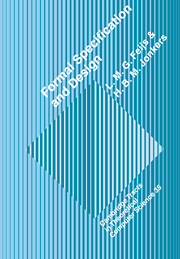Preface
Published online by Cambridge University Press: 02 November 2009
Summary
This book is about formal specification and design techniques, including both algebraic specifications and state-based specifications.
The construction and maintenance of complex software systems is a difficult task and although many software projects are started with great expectations and enthusiasm, it is too often the case that they fail to achieve their goals within the planned time and with the given resources. The software often contains errors; attempts to eliminate the errors give rise to new errors, and so on. Moreover, the extension and adaptation of the software to new tasks turns out to be a difficult and tedious task, which seems unsuitable for scientific methods.
This unsatisfactory situation can be improved by introducing precise specifications of the software and its constituent parts. When a piece of software P has a precise specification S say, then ‘P satisfies S’ is a clear statement that could be verified by reasoning or that could be falsified by testing; users of P can read S and rely on it and the designer of P has a clearly formulated task. When no precise specifications are available, there are hardly any clear statements at all, for what could one say: ‘it works’ or more often ‘it almost works’? Without precise specifications, it becomes very difficult to analyse the consequences of modifying P into P', for example, and to make any clear statements about that modification. Therefore it is worthwhile during the software development process to invest in constructing precise specifications of well-chosen parts of the software system under construction. Writing precise specifications turns out to be a considerable task itself.
- Type
- Chapter
- Information
- Formal Specification and Design , pp. xiii - xviPublisher: Cambridge University PressPrint publication year: 1992



